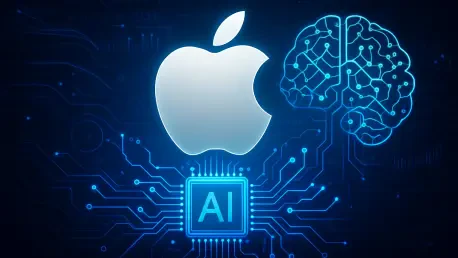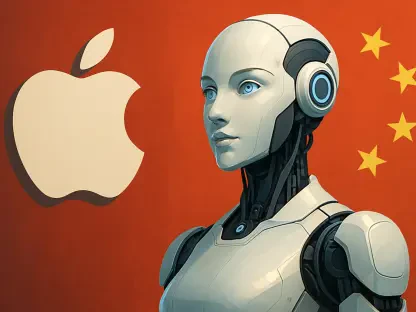Imagine a world where your smartphone not only anticipates your needs but transforms daily tasks with seamless, intelligent assistance, driving Apple’s intensified push into artificial intelligence (AI). This vision is positioning the company at the forefront of a tech revolution. As AI reshapes consumer technology, Apple’s hefty investments and strategic moves have sparked widespread discussion among industry experts, analysts, and tech enthusiasts. This roundup dives into diverse opinions and perspectives on Apple’s AI ambitions, exploring how the company aims to maintain its competitive edge. The purpose is to synthesize varying viewpoints, offering a comprehensive look at the implications of Apple’s efforts in this rapidly evolving field.
Diverse Perspectives on Apple’s AI Ambitions
Resource Allocation and Talent Acquisition: Bold Moves or Risky Bets?
Industry observers have noted Apple’s significant reallocation of personnel to AI-focused projects, signaling a major shift in internal priorities. Many analysts praise this move as a necessary step to keep pace with rivals who have already embedded AI deeply into their ecosystems. The consensus among tech strategists is that redirecting a substantial workforce toward AI innovation demonstrates a commitment to long-term growth over short-term gains.
However, some financial experts caution that such a heavy focus on AI could strain other areas of Apple’s business. Concerns linger about overextending resources, especially as the company balances multiple product lines. A few commentators suggest that while the intent is clear, the execution must ensure that core offerings like hardware design do not suffer from divided attention.
Additionally, Apple’s acquisition of seven smaller firms this year to bolster AI capabilities has drawn mixed reactions. While many in the tech community view this as a savvy way to fast-track expertise, others worry about integration challenges. The debate centers on whether these smaller entities can align with Apple’s cohesive brand identity without creating operational friction.
Apple Intelligence Rollout: Innovation Meets Caution
The introduction of over 20 AI-driven features under the Apple Intelligence banner, such as visual intelligence and writing tools, has been met with enthusiasm by user-focused reviewers. Tech bloggers highlight the practical impact of upcoming tools like an AI-powered workout buddy, which promises to personalize fitness experiences. This user-first approach is often cited as a strength, aligning with Apple’s reputation for intuitive design.
Yet, the delay of major updates to Siri until next year has sparked criticism from some industry watchers who argue that Apple risks losing ground to competitors. A segment of analysts points out that while features like live translation are on the horizon, the slower rollout could frustrate users expecting immediate advancements. The tension between innovation and perfection remains a hot topic in tech forums.
On the flip side, several product reviewers defend Apple’s cautious pace, emphasizing that rushed releases often lead to subpar experiences. This perspective holds that prioritizing polished, reliable features over speed could ultimately strengthen user trust. The discussion reveals a divide between those who value rapid deployment and those who advocate for meticulous refinement.
Competitive Positioning: Deliberate Pace in a Fast-Moving Race
Apple’s measured approach to AI deployment has been a focal point for industry leaders, with many applauding the focus on quality over haste. Tech consultants often argue that in an era of rapid innovation, Apple’s strategy of avoiding unpolished launches sets a higher standard for the industry. This viewpoint suggests that patience could redefine what success looks like in the AI domain.
Contrasting opinions emerge from competitors’ advocates who believe Apple’s slower tempo might allow rivals to capture market share with alternative form factors like AI glasses. Some market analysts speculate that while Apple remains confident in the iPhone’s enduring relevance, emerging technologies could challenge its centrality. This debate underscores differing visions for the future of personal tech.
A third angle comes from global tech commentators who note that Apple’s strategy aligns with varying rates of AI adoption worldwide. In regions where consumers prioritize reliability, Apple’s approach may resonate more strongly than aggressive innovation. This perspective highlights how cultural and market differences influence opinions on the company’s positioning in the AI race.
Strategic Investments and Ecosystem Focus: A Winning Formula?
Apple’s hybrid investment model, combining internal funding with third-party capital and targeted acquisitions, garners significant attention from financial analysts. Many see this as a balanced way to fuel AI growth without overwhelming capital expenditure. The acquisition spree this year is often compared favorably to broader industry trends, positioning Apple as a formidable player against giants like Meta.
Some startup founders and venture capitalists, however, question whether these acquisitions will deliver the expected innovation boost. There’s a concern that smaller firms might struggle to scale within Apple’s vast ecosystem, potentially diluting the impact of these investments. This skepticism fuels discussions on whether organic development might yield better results than external purchases.
A unique point of agreement among tech ecosystem experts is the emphasis on fortifying the iPhone as the central hub for AI innovations. Reviewers and analysts alike note that this focus ensures Apple’s relevance amid shifting tech paradigms. The strategy is often hailed as a smart move to integrate AI seamlessly into users’ daily lives, reinforcing the device’s indispensable role.
Key Takeaways from Apple’s AI Journey
Reflecting on the varied insights, Apple’s substantial investments and workforce shifts stand as clear evidence of its dedication to AI as a transformative force. Record revenue in the third quarter of this year further bolstered confidence among stakeholders, as highlighted by numerous financial reviews. The rollout of new features, despite some delays, was widely seen as a step toward embedding intelligence into everyday interactions.
Tech enthusiasts and investors are encouraged to monitor adoption trends of Apple’s AI tools, with many analysts suggesting that these metrics could signal broader market shifts. Observing how users integrate these features into personal routines offers a practical lens for assessing impact. Such scrutiny is often recommended as a way to gauge investment potential in related sectors.
Looking ahead, a critical next step involves staying informed about Apple’s progress with delayed updates like Siri enhancements, as these could redefine user expectations. Exploring complementary resources on AI trends in consumer tech is advised to deepen understanding of the landscape. Ultimately, tracking how Apple balances speed and quality in its ongoing efforts provides valuable insights for anticipating the future of technology.









